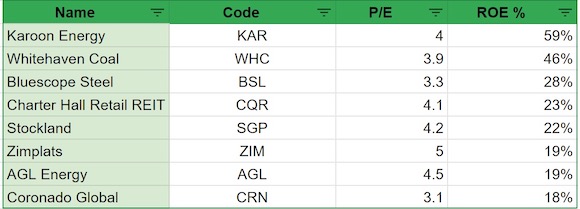What are the cheapest stocks on the ASX right now?
One way to find out is to filter stocks by the Price-to-Earnings ratio (P/E).
The ASX 200’s historical P/E ratio has averaged around 15–16.
So a stock with a P/E of less than 10 is relatively ‘cheap’ on that basis. A P/E multiple of less than five is dirt cheap.
Filtering for mid-to-large stocks, here are the stocks with a P/E of five or less:
|
|
| Source: CommSec |
Unsurprisingly, the list is dominated by resource stocks and REITs.
Historically, resource stocks trade at low P/E multiples, being cyclical companies in mature industries paying out big dividends.
Are coal stocks undervalued?
What is interesting are the three coal stocks.
Coronado Global, Whitehaven Coal, and New Hope are the best-performing stocks on that list, thanks to surging coal prices.
Yet despite their recent stock price performance, the stocks still look dirt cheap.
Take Whitehaven. The coal stock is up 200% this year. And it’s up almost 900% from this time two years ago.
Nonetheless, WHC shares still trade at a P/E multiple of around four.
And if you look ahead, Whitehaven looks even cheaper.
Based on consensus earnings estimates, Whitehaven’s forward FY23 P/E is 2.9 on a projected Return on Equity (ROE) of 56%.
On those estimates, Whitehaven is priced like a scuttlebutt stock on the expected ROE of a monopolistic software giant.
So does Whitehaven offer insane value? Or should investors be wary?
The stock is trading at all-time highs and is a cyclical commodity operating at a time of global recession fears.
But the price of coal is unlikely to crater any time soon as the world still deals with tight energy supplies.
Yet markets are always looking ahead. Stellar past performance makes for great memories but lousy inferences.
The same consensus estimates having Whitehaven post FY23 ROE of 56% also have Whitehaven’s ROE slipping to 13% by FY25.
Whitehaven is a commodity stock — a price taker. And commodities are highly cyclical.
That said, bullish investors will point to the unique circumstances favouring both demand for and supply of coal.
The world is hungry for energy but has neglected investment in fossil fuels like coal in pursuit of renewables.
In its FY22 report, Whitehaven noted (emphasis added):
‘Energy security is expected to remain a key priority while there is a continuing global energy supply shortfall – particularly for high quality thermal coal. It is likely to take several years before additional supply or alternative energy sources are available in the global energy complex to rebalance supply and demand. Throughout the coming multi-decade decarbonisation transition, reliable baseload energy will be required, delivering continued strong demand for Whitehaven’s high-quality coal that supports lower emissions relative to other coal products. As a result, ongoing prices for high-CV thermal coal are likely to remain well supported.’
If coal prices remain elevated, WHC may rise higher given its lowly current P/E.
But low P/E multiples aren’t sufficient fodder for great stock analysis.
Often, P/E ratios can mislead.
P/E is not the same as value
Simply picking stocks with the lowest P/E ratios is a doomed exercise.
What looks cheap can always get cheaper.
Not to mention that some things are cheap for a reason.
A garage sale of trinkets has plenty of low-priced items but hardly any bargains. One man’s trash is rarely another man’s treasure.
Trash is trash.
If we go back to our P/E table, we’ll see that Virgin Money has a measly P/E multiple of 3.6.
A bargain?
Not necessarily.
Consensus estimates have Virgin Money posting a ROE of 9.7% in FY22 (VUK is yet to release full-year accounts) and 8.4% in FY24.
It looks like Virgin Money is cheap for a reason, with a low return on equity set to fall even lower in the coming years.
You can supplement a P/E filter with another, more fundamental measure called Return on Equity (ROE).
ROE measures how effectively a business uses capital to turn a profit. Buffett is a big fan of ROE as a metric.
If we filter the same mid-to-large stocks for a P/E ratio of less than five and a ROE of more than 15%, we get the following list:
|
|
| Source: CommSec |
Many of the same names pop up and some, like Virgin Money, don’t.
And we get more context.
For instance, Coronado and Whitehaven have similar P/E multiples but very different ROE figures.
Of course, you can make these tables even more insightful by using three- or five-year historic ROE averages to smooth over any aberrations.
All up, a low P/E is better used as insight into the market’s thinking.
If a stock is trading at a very low multiple, the market is telling you it has low expectations of future growth (or lack of visibility of future growth for under-the-radar stocks).
You can use that to your advantage.
Howard Marks: non-consensus and right
In a famous memo to clients, fund manager Howard Marks wrote about the benefits of being contrarian and right.
Marks argued the best returns stemmed from accurate non-consensus ideas. To earn outsized returns, you have to be non-consensus and right…
‘Everyone’s forecasts are, on average, consensus forecasts. If your prediction is consensus too, it won’t produce above-average performance even if it’s right. Superior performance comes from accurate non-consensus forecasts. But because most forecasters aren’t terrible, the actual results fall near the consensus most of the time — and non-consensus forecasts are usually wrong.
‘The problem is that extraordinary performance comes only from correct non-consensus forecasts, but non-consensus forecasts are hard to make, hard to make correctly and hard to act on.’
P/E multiples are clues into consensus forecasts.
P/E ratios reflect the composite market outlook on a stock’s future earnings growth.
Taking that consensus view, you can then work to determine whether the consensus is justified…or not.
Stock picking for retirement
The importance of using financial metrics like P/E and ROE appropriately is undeniable.
You don’t want to get suckered into doomed investments based on misleading ratios.
But you also want to glean insights into the market’s thinking so you can use it to your advantage.
The importance of acting soundly on useful information is doubly important if you are making investments for your retirement.
Your money is on the line…and your future.
That’s why I highly recommend you watch our special ‘30% Nest Egg’ presentation by our veteran trader Murray Dawes this Thursday.
Murray will show you how to build a nest egg while managing risk and avoiding big drawdowns.
Secure your spot to watch ‘The 30% Nest Egg’ for free by clicking here.
Until next week,
 |
Kiryll Prakapenka,
For Money Morning



